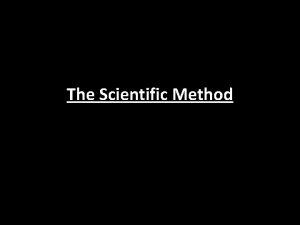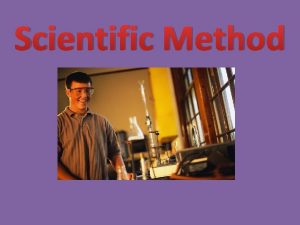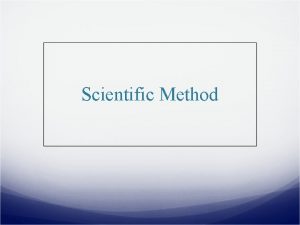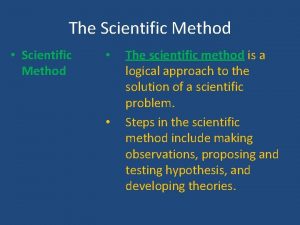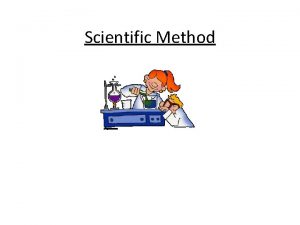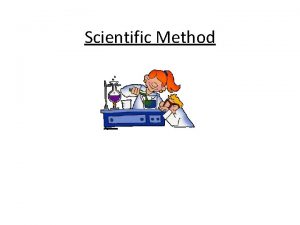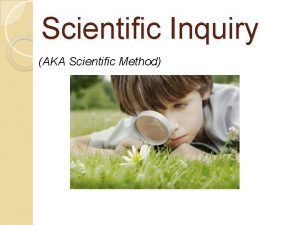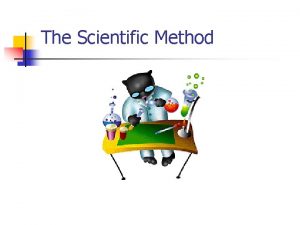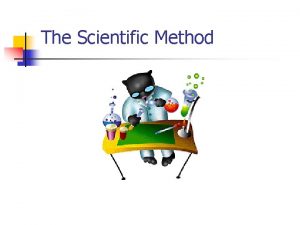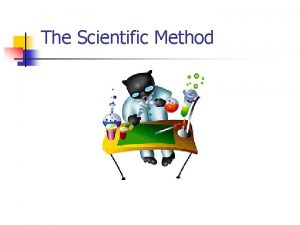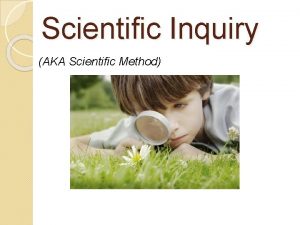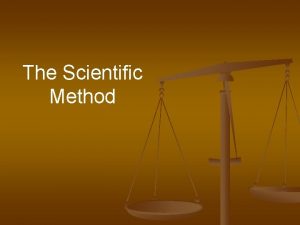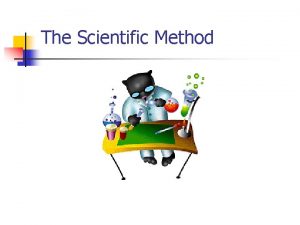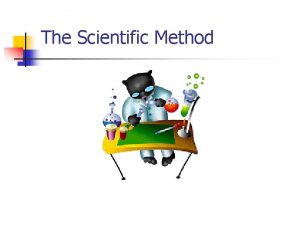Chapter 1 The Scientific Method The Scientific Method






















- Slides: 22

Chapter 1 The Scientific Method

The Scientific Method involves the following steps: 1. Making observations 2. Formulating a hypothesis 3. Designing a controlled experiment 4. Collecting and interpreting data 5. Forming a conclusion 6. Comparing the conclusion with existing knowledge 7. Reporting and publishing the results 8. Developing theories and principles • 2

Scientific Method

The Edward Jenner Story

e. g. Edward Jenner’s investigation Jenner noticed that people who caught Cowpox (a minor disease) did not seem to get Smallpox (a fatal disease). Jenner hypothesised that if someone got cowpox and recovered then they would not get smallpox. The Scientific method 1. The Scientist makes an Observation 2. A hypothesis is formed. (A hypothesis is an educated guess based on the initial observation).

3. An experiment is Jenner injected a boy with designed to test the cowpox and later injected hypothesis. him with smallpox. 4. Interpretation of results. Jenner tested the boy for smallpox and found that he did not have it. 5. Conclusion Jenner concluded that a person who once had cowpox would not get smallpox.

• Based on the results of an experiment a hypothesis can be supported, rejected or changed and retested. • Details of the experiment and the results can be published in a Journal to inform the scientific community and allow further research. • If a hypothesis is continually supported by many experiments it becomes known as a theory. • When a theory has been shown to be correct under all conditions then it becomes known as a Law or Principle.

1. Observation You observe something using your senses or machines which are basically extensions of those senses. • 8

Question • You ask a question about what you observed. • Form a question about a specific event or reaction. • State it as a problem or question: How does human activity affect global warming? Why are honeybee populations suddenly declining? What enables birds to migrate such long distances? • 9

2. Form a Hypothesis: is an educated guess based on observations. You predict what you think the answer to your question might be. • 10

3. Design an Experiment Design controlled experiments, a series of steps, to test the hypothesis, to see if it is correct or not. • 11

4. Collect & Analyse Data Collect information, measurements and observations from experiements. • 12

5. Draw Conclusions Determine from the data collected if the hypothesis was correct or incorrect • 13

6. Compare You compare your conclusion with existing knowledge, to see if it supports or rejects existing knowledge. • 14

7. Report and Publish results Details of the experiment and the results can be published in a Journal to inform the scientific community and allow further research. • 15

8. Develop a theory or principle • If a hypothesis is continually supported by many experiments it becomes known as a theory. • When a theory has been shown to be correct under all conditions then it becomes known as a Law or Principle. • 16

• Scientific Theory - a general statement of why things work based on hypotheses that have been tested many times • Scientific Law - a statement of what happens in a certain event based on verified observations & experiments

What are the main steps in the Scientific Method? 1. Observation 2. Hypothesis 3. Experiment 4. Result 5. Conclusion


Steps in the scientific method • • • Observation Question Hypothesis Test/Experiment Results Conclusions • 20

• The Scientific Method Quiz An excel quiz on the steps involved

• The Scientific Method
 Information gathered during an experiment
Information gathered during an experiment How is a scientific law different from a scientific theory?
How is a scientific law different from a scientific theory? Hát kết hợp bộ gõ cơ thể
Hát kết hợp bộ gõ cơ thể Frameset trong html5
Frameset trong html5 Bổ thể
Bổ thể Tỉ lệ cơ thể trẻ em
Tỉ lệ cơ thể trẻ em Gấu đi như thế nào
Gấu đi như thế nào Tư thế worms-breton
Tư thế worms-breton Hát lên người ơi
Hát lên người ơi Các môn thể thao bắt đầu bằng tiếng chạy
Các môn thể thao bắt đầu bằng tiếng chạy Thế nào là hệ số cao nhất
Thế nào là hệ số cao nhất Các châu lục và đại dương trên thế giới
Các châu lục và đại dương trên thế giới Công thức tiính động năng
Công thức tiính động năng Trời xanh đây là của chúng ta thể thơ
Trời xanh đây là của chúng ta thể thơ Mật thư anh em như thể tay chân
Mật thư anh em như thể tay chân 101012 bằng
101012 bằng Phản ứng thế ankan
Phản ứng thế ankan Các châu lục và đại dương trên thế giới
Các châu lục và đại dương trên thế giới Thể thơ truyền thống
Thể thơ truyền thống Quá trình desamine hóa có thể tạo ra
Quá trình desamine hóa có thể tạo ra Một số thể thơ truyền thống
Một số thể thơ truyền thống Bàn tay mà dây bẩn
Bàn tay mà dây bẩn Vẽ hình chiếu vuông góc của vật thể sau
Vẽ hình chiếu vuông góc của vật thể sau


























